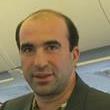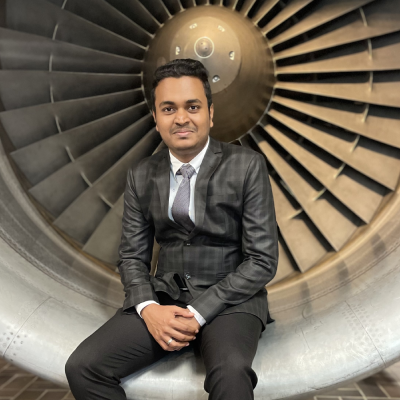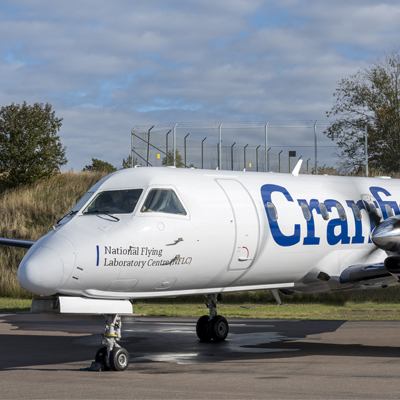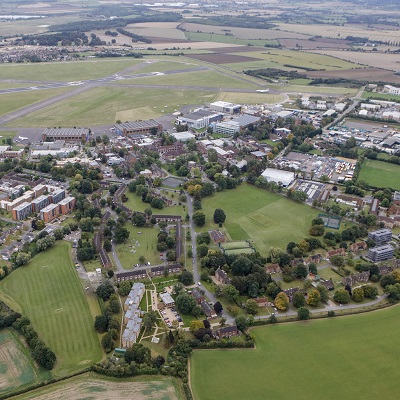Overview
- Start dateSeptember or March
- DurationFull-time MSc: One year
- DeliveryTaught modules 10%, group project 50%, individual research project 40%
- QualificationMSc
- Study typeFull-time
- CampusCranfield campus
Who is it for?
This option is suitable for those students wishing to gain an overview of the whole aircraft design process as well as the design of aircraft structures and systems.
Why this course?
This Aircraft Design option aims to provide a comprehensive overview of whole aircraft configuration design as well as structures and systems. A holistic teaching approach is taken to explore how the individual elements of an aircraft can be designed and integrated using up-to-date methods and techniques. You will learn to understand how to select and integrate specific systems such as fuel systems, and their effect on the aircraft as a whole.
You will have the opportunity to fly during a Student Experience Flight in our National Flying Laboratory Centre’s (NFLC) light aircraft. This flight experience will complement your MSc studies, focussing on the effects of controls, aircraft stability and angle of attack. During the flight you will have the opportunity to take control of the aircraft. Each experience is 2 to 3 hours in duration and includes a pre-flight safety briefing outlining the details of the manoeuvres to be flown, a flight of approximately 1 hour, and a post-flight debrief. Read Hari's blog on his flight experience.
We have been at the forefront of postgraduate education in aerospace engineering since 1946. Aerospace Vehicle Design at Cranfield University was one of the original foundation courses of the College of Aeronautics. Graduates of this course are eligible to join the Cranfield College of Aeronautics Alumni Association (CCAAA), an active community which hold a number of networking and social events throughout the year.
Cranfield University is well located for students from all over the world, and offers a range of library and support facilities to support your studies. This enables students from all over the world to complete this qualification whilst balancing work/life commitments.
Informed by industry
The course has an Industrial Advisory Committee with senior members from major UK aerospace companies, government bodies, and the military services. The committee meets twice a year to review and advise on course content, acquisition skills and other attributes that are desirable for graduates of the course. Panel members include:
• Airbus,
• BAE Systems,
• BOEING,
• Department of National Defence and the Canadian Armed Forces,
• GKN Aerospace,
• Messier-Dowty,
• Royal Air Force,
• Royal Australian Air Force,
• Thales UK.
Course details
The Aircraft Design option consists of nine mandatory modules and 11 optional modules. You are also required to complete a group design project and an individual research project. Delivered via a combination of structured lectures, industry guest lectures, computer based workshops and private study.
A unique feature of the course is that we have four external examiners, two from industry who assess the group design project and two from academia who assess the individual research project.
Course delivery
Taught modules 10%, group project 50%, individual research project 40%
Group project
The extensive group design project is a distinctive and unique feature of this course. This teamwork project takes place over six months and recreates a virtual industrial environment bringing together students with various experience levels and different nationalities into one integrated design team.
Students are given responsibility for the detailed design of a significant part of the aircraft, for example, forward fuselage, fuel system, landing gear, environmental control system or wing. The project will progress from the conceptual phase through to the preliminary and detail design phases. You will be required to run project meetings, produce engineering drawings and detailed analyses of your design. Problem solving and project coordination must be undertaken on a team and individual basis. At the end of the project, groups are required to report and present findings to a large panel of senior engineers from industry.
This element of the course is both realistic and engaging, and places the student group in a professional role as aerospace design engineers. Students testify that working as an integrated team on real problems is invaluable and prepares them well for careers in a highly competitive industry.
Watch past presentation videos (YouTube) to give you a taster of our innovative and exciting group projects:
Individual project
The individual research project aims to provide the training necessary for you to apply knowledge from the taught element to research. The project may be theoretical and/or experimental and drawn from a range of topics related to the course and suggested by teaching staff, your employer or focused on your own area of interest. It provides the opportunity for you to deepen your knowledge of an area that is of particular interest, and is often associated with a real-world problem that one of our industry partners is looking to resolve.
Examples in conceptual aircraft design topics:
Aircraft configurations appropriate to hybrid-electric designs;
Design and testing of a bird like flapping wing ultra-light aircraft;
Design of a human powered helicopter;
Conceptual design of a high speed VIP transport helicopter;
Conceptual design of a hypersonic space launcher;
The conceptual design of a commuter seaplane;
An ultra-light tilt-wing-rotor aircraft for short take-off and landing capability;
Scale factor for the structure design of a BWB Aircraft;
Design of a human powered helicopter (HPH);
Conceptual fesign of a two-seat training/touring 'Autogyro'.
Examples in aircraft structural design and analysis topics:
Investigation in the numerical representation of damage on CFRP stiffened panels and behaviour under combined loading;
Delamination growth of carbon fibre composites under fatigue loads;
Experimental testing and numerical analysis of aircraft bolt jointed sandwich composites;
Strength prediction via testing and/or numerical simulation of bolted joints on fibre reinforced laminates;
Composite design considerations for trailing arm landing gears;
Fatigue behaviour of bolted joints on CFRP laminates following pull through failure;
Simulation of thermal residual stresses of CFRP wing;
Fatigue of buckled composite stiffened panel;
Dynamic Indentation of composite laminates;
Numerical modelling of through-thickness reinforced composite laminates;
Direct measurement of traction-separation law in fatigue damage of adhesive bonding;
Composite joints reinforced by composite fasteners.
Example aircraft systems design and analysis topics:
Systems/structure design modifications to increase manufacture and assembly rates;
The development of a hypersonic air-breathing propulsion model and the sizing and integration of a propulsion concept;
Environmental control system for aircraft with variable fresh air;
The design of a propeller for an electric microlight aircraft;
Investigation into the characteristics of a boundary layer ingestion system;
Tolerance design for mechanical assemblies in aerospace;
Environmental control system cabin air quality;
Fuel cell powered landing gear taxi system;
The design and integration of a next-generation propulsion concept;
An investigation into hypersonic air-breathing propulsion concepts and fuels;
The design of a propulsion system for an electric microlight aircraft;
Integrated sensors airframe design ;
Tolerance design for mechanical assemblies in aerospace;
Aircraft wing sub-system design for modular assembly;
Design of a scaled test rig for integral wing fuel tank experiments;
Simulating fuel gauging performance using pressure sensors;
Design of hybrid electric fuel cell propulsion system for a training helicopter;
Thermal management of aircraft systems on future more electric aircraft with ultra-high bypass ;
Future airliner cabin design;
Actuation system health monitoring;
Re-entry space vehicle – actuation system design and analysis;
Reducing wing fuel tank leak test times during assembly;
Aircraft level analysis of novel integrated thermal management systems.
Modules
Keeping our courses up-to-date and current requires constant innovation and change. The modules we offer reflect the needs of business and industry and the research interests of our staff and, as a result, may change or be withdrawn due to research developments, legislation changes or for a variety of other reasons. Changes may also be designed to improve the student learning experience or to respond to feedback from students, external examiners, accreditation bodies and industrial advisory panels.
To give you a taster, we have listed the compulsory and elective (where applicable) modules which are currently affiliated with this course. All modules are indicative only, and may be subject to change for your year of entry.
Course modules
Compulsory modules
All the modules in the following list need to be taken as part of this course.
Design and Analysis of Composite Structures
| Aim |
To introduce you to the composite materials, manufacturing techniques and analysis methods for the design of aerospace composite structures. |
|---|---|
| Syllabus |
• Overview of composites manufacturing techniques. • Micromechanics and macro mechanics for stiffness and strength analysis of a FRP ply; Macro mechanics, constitutive equation, stiffness and strength analysis of a FRP laminate; Thermal and moisture residual stresses in a FRP laminate. • Stress analysis of an open section FRP composite structure subjected to various loadings. • Stress analysis of a closed section FRP composite structure subjected to various loadings. • Design guidelines and examples for composite structure design and analysis. • Computer programmes for laminate stress, buckling of laminate and stiffened skin. |
| Intended learning outcomes |
On successful completion of this module you should be able to:
|
Design of Airframe Systems
| Aim |
|
|---|---|
| Syllabus |
|
| Intended learning outcomes |
On successful completion of this module you should be able to:
|
Aircraft Performance
| Aim |
To facilitate you in gaining fundamental knowledge of the theory of conventional fixed wing aircraft performance to a level suitable for an aerospace vehicle designer. In particular, to provide you with the ability to apply aircraft performance theory, practically in the context of aerospace vehicle design. |
|---|---|
| Syllabus |
• Aircraft Cruising Performance. • Aircraft Climb and Descent Performance. • Aircraft Take-off and Landing Performance. • Aircraft Manoeuvre Performance. • Flight Path Performance Estimation. • Aircraft Performance Measurement. |
| Intended learning outcomes |
On successful completion of this module you should be able to:
|
Aircraft Stability and Control
| Aim |
To provide an introduction to the fundamentals of aircraft stability and control. |
|---|---|
| Syllabus |
• Aircraft aerodynamic controls. • Static equilibrium and trim. • Longitudinal static stability, trim, pitching moment equation, static margins. • Lateral-directional static stability. • Introduction to dynamic stability, first and second order responses. • Equations of motion and modal characteristics. |
| Intended learning outcomes |
On successful completion of this module you will be able to:
|
Design for Manufacture and Operation
| Aim |
To ensure that while you design your structure they are aware of the constraint imposed by manufacturing and operational considerations. The influence of designing for maintainability will have a considerable effect on the design of both the structure and aircraft systems and a considerable effect on the life cycle cost of the vehicle. The taught material will have immediate practical application to the Group Design Project. |
|---|---|
| Syllabus |
|
| Intended learning outcomes |
On successful completion of this module you should be able to:
|
Flight Test Experience
| Aim |
To provide you with flights in the Flying Laboratory in support of the lecture course in Aircraft Aerodynamics, Aircraft Performance, and Aircraft Stability and Control. These flights are key for students who are from a non-aeronautical background, and will also serve as a refresher for the remaining students. |
|---|---|
| Syllabus |
|
| Intended learning outcomes |
On successful completion of this module you should be able to:
|
Initial Aircraft Design
| Aim |
|
|---|---|
| Syllabus |
|
| Intended learning outcomes |
On successful completion of this module you should be able to:
|
Loading Actions
| Aim |
To provide you with knowledge of all the main loading cases including those encountered on the ground, in the air and those induced by the environment. |
|---|---|
| Syllabus |
• Standard requirements, their application, interpretation and limitations.
• Flight loading cases: symmetric manoeuvres, pitching acceleration, gust effects, asymmetric manoeuvres, roll and yaw. • Balance equations: rigid airframe response, control movements and forces. • Ground loading cases: Airload distributions. • Structural design data: Inertia relief and effect on shear force, bending moment and torque diagrams. • Factors: load factors, their basis and restrictions. |
| Intended learning outcomes |
On successful completion of this module you should be able to:
|
Reliability, Safety Assessment and Certification
| Aim |
To provide you with an introduction to the aircraft airworthiness as well as knowledge of reliability assessment methods, safety assessment methods, and certification issues associated with the design of Aircraft Systems (including weapon systems and survivability). To familiarise you with current air accidents investigation techniques and processes. |
|---|---|
| Syllabus |
• Reliability • Reliability requirements – JAR25-AC.1309 • Probabilities of failure, MTBF, MTBR, etc. • Reliability models – series and parallel systems, common mode failures • Safety Assessment Analysis Methods • Failure Modes and Effects Analysis (FMEA) • Fault Tree Analysis (FTA) • Reliability predictions • Common Cause Analysis (CCA) • System Safety Assessment Process • Functional Hazard Analysis (FHA) • Preliminary System Safety Assessment (PSSA) • Air Accidents Investigation |
| Intended learning outcomes |
On successful completion of this module you should be able to:
|
Elective modules
One of the modules from the following list needs to be taken as part of this course.
Aeroelasticity
| Aim |
To introduce you to the importance of aeroelastic phenomena, basics of aeroelasticity and analysis methods for the design of aircraft structures. |
|---|---|
| Syllabus |
• Introduction (historical review, aeroelastic phenomena and design requirements);
• Structural and aerodynamic stiffness; • Static aeroelasticity: torsional divergence, control effectiveness and reversal; • Structural vibration and modal analysis; • Aerodynamic loads on an oscillating lifting surface; • Characteristics of flutter and important design parameters; • Methods for aeroelastic analysis (divergence and flutter speed prediction); • Gust response of rigid and flexible airframes; • This module has additional accompanying tutorials and computer workshops as required. |
| Intended learning outcomes |
On successful completion of this module you should be able to:
|
Aerospace System Development and Life Cycle Model
| Aim |
To introduce you to system engineering concepts, system lifecycle models and system design processes and methods. |
|---|---|
| Syllabus |
• Life Cycle Models. • System Requirements. • Systems Design. • System Integration, Verification and Validation. |
| Intended learning outcomes |
On successful completion of this module you should be able to:
|
Aircraft Aerodynamics
| Aim |
The aim of this module is to provide you with the knowledge of the Atmosphere and of the basic aerodynamic characteristics of a conventional aircraft in the context of its mechanics of flight. |
|---|---|
| Syllabus |
|
| Intended learning outcomes |
On successful completion of this module a you should be able to:
|
Aircraft Power Plant Installation
| Aim |
To introduce you to the engine and aircraft-related aspects of the propulsion system, with the primary emphasis being placed on gas turbine engines. |
|---|---|
| Syllabus |
• Relations between specific fuel consumption, specific range and thermal and overall efficiencies for various engine types including turbo-props. • Choice of cycle for various applications. • Brief assessment of engine size required and engine / airframe matching including the importance of the airworthiness performance requirements. • Impact of engine rating on engine / airframe matching. • Impact on engine installation of various systems required by the aircraft. |
| Intended learning outcomes |
On successful completion of this module you should be able to:
|
Computer Aided Design
| Aim |
The aim of this module is to introduce you to the role of Computer Aided Design technologies in a modern Integrated Product Development process and provide hands-on experience of CAD using the CATIA v5 software. |
|---|---|
| Syllabus |
|
| Intended learning outcomes |
On successful completion of this module you should be able to:
|
Detail Stressing
| Aim |
|
|---|---|
| Syllabus |
• The structural function of aircraft components. Definition of Limit, Proof and Ultimate loads and Factors for Civil and Military aircraft. • Basic formulas for stress analysis. Stress strain curves for metallic materials. Material equivalents. Concept of Reserve Factors (RF) and Margins of Safety (MS). • Material data. Design guidelines for mechanically fastened joints. Lugs. Strength of bolted/riveted joints. Usage of approved aerospace components. • Structures under bending and compression. Euler buckling, flange buckling, inter-rivet buckling. Buckling of struts and plates. Shear buckling of webs. • Generalised stress strain curves. • Plastic bending and form factors. • Rivet and bolt group analysis. • Analysis of thin walled structures. • Preparation of a detailed Stressing Report and Reserve Factor summary tables for a classroom exercise to be completed during this module. |
| Intended learning outcomes |
On successful completion of this module you should be able to:
|
Fatigue, Fracture Mechanics and Damage Tolerance
| Aim |
To provide you with an understanding of the theories of Fatigue and Fracture Mechanics, and to demonstrate how these methods and the damage tolerance design concepts are applied to the design and testing of aircraft structures and Airworthiness Certification |
|---|---|
| Syllabus |
• Fatigue analysis: Traditional S-N curve approach: calculation of crack initiation life; mean stress effect, notch effect; Miner’s cumulative damage rule for variable amplitude loads. • Aircraft fatigue loads: Typical aircraft load spectra for use in the laboratory and computer simulation. • Fracture Mechanics: Basic Theory of Linear Elastic Fracture Mechanics (LEFM): Stress Intensity Factor, fracture toughness, strain energy release rate; plane stress and plane strain, crack tip plastic zone; residual strength; prediction of fatigue crack growth. Numerical techniques for crack prediction and analysis. • Damage Tolerance: Damage tolerant design methods and technologies for composites and metals. Fatigue monitoring in flight/service and structural health monitoring. Inspection methods. CAA and FAA Regulations and their relationship to Airworthiness Certification Material selection. |
| Intended learning outcomes |
On successful completion of this module you should be able to:
|
Finite Element Analysis
| Aim |
|
|---|---|
| Syllabus |
|
| Intended learning outcomes |
On successful completion of this module you should be able to:
|
Integrated Vehicle Health Management
| Aim |
To provide you with an introduction to the leading IVHM technologies and concepts being implemented in various health monitoring systems, and their application to aircraft design. |
|---|---|
| Syllabus |
• Sensors and Instrumentation for different aircraft sub-systems (aircraft structures, aero-propulsion systems, electric power and power distribution systems, avionics, etc.). • Fault detection and isolation techniques. • Reasoning methods (model-based, case-based, etc.) and their use in aircraft health management. • Prognosis approaches for aircraft health management. • Physics of failure approaches. • IVHM Design for aircraft health management. • Structural health monitoring. • Cost benefit analysis of IVHM implementation. |
| Intended learning outcomes |
On successful completion of this module a you should be able to:
|
Landing Gear Design
| Aim |
|
|---|---|
| Syllabus |
|
| Intended learning outcomes |
On successful completion of this module you should be able to:
|
Structural Stability
| Aim |
To provide you with a fundamental understanding of the buckling of thin walled structures and the ability to calculate the buckling load of a component. |
|---|---|
| Syllabus |
|
| Intended learning outcomes |
On successful completion of this module you should be able to:
|
Teaching team
You will be taught by a wide range of subject specialists from the University and industry professionals who draw on their research and industrial expertise to provide stimulating and relevant input to your learning experience. The teaching on some taught modules is also supported by visiting speaker's lectures from both industry and the military. Former speakers have included senior representatives from Airbus, BAE Systems, Boeing and Eurocopter. The Course Director for the September intake for this programme is Jack Stockford. The March intake Course Director is Dr David Judt.
Accreditation
The Aerospace Vehicle Design MSc is accredited by Mechanical Engineers (IMechE) and the Royal Aeronautical Society (RAeS) on behalf of the Engineering Council as meeting the requirements for further learning for registration as a Chartered Engineer (CEng). Candidates must hold a CEng accredited BEng/BSc (Hons) undergraduate first degree to show that they have satisfied the educational base for CEng registration.
Your career
This MSc is valued and respected by employers worldwide. The applied nature of this course ensures that our graduates are ready to be of immediate use to their future employer and has provided sufficient breadth of understanding of multi-discipline design to position them for accelerated career progression.
Graduates from this option have gone on to pursue engineering careers in disciplines such as structural design, stress analysis or systems design.
Many of our graduates occupy very senior positions in their organisations, making valuable contributions to the international aerospace industry. Typical student destinations include BAE Systems, Airbus, Dassault and Rolls-Royce.
Cranfield’s Career Service is dedicated to helping you meet your career aspirations. You will have access to career coaching and advice, CV development, interview practice, access to hundreds of available jobs via our Symplicity platform and opportunities to meet recruiting employers at our careers fairs. Our strong reputation and links with potential employers provide you with outstanding opportunities to secure interesting jobs and develop successful careers. Support continues after graduation and as a Cranfield alumnus, you have free life-long access to a range of career resources to help you continue your education and enhance your career.
How to apply
Click on the ‘Apply now’ button below to start your online application.
See our Application guide for information on our application process and entry requirements.
My course prepared me to be an aircraft designer with good hands-on experience in design software, planning and budgeting for projects. Here I have learnt team work and project management skills. Using these skills I have set up a company back in India which focuses on the engineering applications of drones.
As a person who always had a dream of becoming a flight test engineer in the aerospace sector, I felt that the Flight Experience module - onboard Cranfield's Saab 340B, the flying classroom - was valuable as an initial insight on how a flight test is conducted within the industry. It really helped me to understand and verify the overall theory evolving the flight physics both in term of lift and drag, as well as the stability of the aircraft.
I chose to study Aerospace Vehicle Design MSc at Cranfield University as it was a unique course that would give me the opportunity to specialise in the design of aircraft. A highlight from my MSc would have to be the group design project and meeting new friends from all around the world. It made the entire journey a breeze, with a lot of support and many late nights. Once I have finished my MSc I will be starting new job at Airbus.
I chose to study at Cranfield University because of the feedback provided by former students, so as well as its ties with industry. The Aerospace Vehicle Design MSc was was exactly what I was looking for in terms of the theory covered in the taught modules and being able to apply this to the group and thesis projects.
A highlight from my time at Cranfield University would have to be taking part in the flying experience onboard the Cranfield acrobatic plane.












.ashx?h=400&w=400&la=en&hash=AE9FD4CF161A12723C148F896750A589F2572111)




